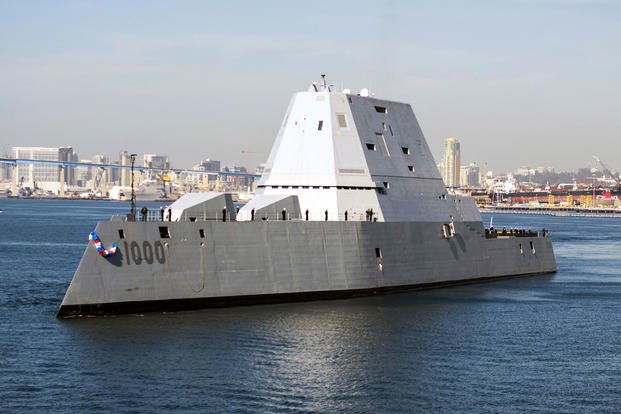
The guided-missile destroyer USS Zumwalt (DDG 1000) arrives at its new homeport in San Diego on Dec. 8, 2016. (U.S. Navy photo by Petty Officer 3rd Class Emiline L. M. Senn)
On August 21st, new ship-counting rules went into effect for the US Navy, postponing the 2 Zumwalt-class destroyers.
A provision of the Fiscal Year 2019 National Defense Authorization Act (FY 2019 NDAA) went into effect, making it impossible for a ship to be included in the Naval Vessel Register’s list of battle force ships until it has been fully delivered to the Navy – and in the case of ships with a phased delivery, where the Navy takes custody of the hull but adds in the combat system or electronics later, that means the final delivery date.
So, upon passage of the bill, Zumwalt-class destroyers USS Zumwalt (DDG-1000) and yet-to-be commissioned Michael Monsoor (DDG-1001) were taken off the battle force ship count and will not be added back on until they complete a combat system activation in San Diego.
The Zumwalt was delivered to the Navy in May 2016 and was commissioned in October of the same year. It arrived in San Diego in December 2016 to begin its combat system activation, which takes approximately 18-month process.
The proposal for the change in when the delivery of a ship is deemed to occur initially happened in the FY 2017 NDAA. A Senate report, accompanying the FY 2017 NDAA stated the following:
“The committee notes that justification materials, which accompanied the President’s fiscal year 2016 and 2017 budgets, as well as Department of Defense Selected Acquisition Reports for the CVN-78 class aircraft carrier program, list the delivery date of USS John F. Kennedy (CVN-79) as June 2022. However, the Navy plans to deliver this ship in two phases. Phase I delivery, scheduled to complete in June 2022, will deliver the ship with full propulsion capability, aircraft launch and recovery systems, and safe to sail navigation systems. Phase II delivery, scheduled to complete in September 2024, will add the remaining electronics and ordnance equipment, including the Ship Self-Defense System, weapons systems, and Enterprise Air Search Radar. The committee believes CVN-79 delivery should be deemed to occur at the end of Phase II delivery,”
“Similarly, the committee understands all three ships in the Zumwalt-class will employ a dual delivery approach with hull, mechanical, and electrical (HM&E) systems delivery at the shipbuilder in Maine and combat systems activation in California. In the case of USS Zumwalt (DDG-1000), HM&E delivery is scheduled for 2016 and combat systems activation is scheduled for 2018. The committee notes the President’s fiscal year 2017 budget lists April 2016 as the delivery date. The committee believes Zumwalt-class delivery should be deemed to occur at the completion of the dual delivery approach, following combat systems activation,” the report continued.
On August 22nd, in response to the change in ship-counting Navy spokeswoman Lt. Lauren Chatmas was cited by USNI News as saying “the Navy worked closely with Congress as the FY 2019 NDAA was being developed to ensure accurate characterization of the Zumwalt Class of ships (DDG 1000, DDG 1001, and DDG 1002) and CVN-79 and how these ships will be treated in the battle force count. Given the unique ‘phased-delivery’ of these four ships, the Navy will place them in a special status to reflect preliminary acceptance by the Navy from the shipbuilder, and then on completion of the mission systems and final delivery the Navy will count them in the battle force.”
The Zumwalt-class destroyers have had numerous problems with their commissioning. Shortly after it’s “delivery to the Navy”, prior to arriving in San Diego, on September 21st. It happened following an incident after the ship’s transit from shipbuilder General Dynamics Bath Iron Works, Maine to Naval Station Norfolk, Va. in which the crew discovered “a seawater leak in the propulsion motor drive lube oil auxiliary system for one of the ship’s shafts.” The problem was discovered to be a leak in the lube oil coolers.
After it was commissioned on October 15th, 2016, the Zumwalt suffered additional unspecified engineering trouble. Following that, on November 22nd, the Zumwalt once more lost propulsion in its port shaft during the transit through the Panama Canal. The crew saw water intrusion in two of the four bearings that connect to Zumwalt’s port and starboard Advanced Induction Motors (AIMs) to the drive shafts, as reported by Usni News, citing an unnamed defense official.
The USS Michael Monsoor, the second Zumwalt-class destroyer also had issues. On July 11th, 2018, Usni News reported that the destroyer will need to have a main turbine engine replaced after suffering damage to the turbine blades during acceptance trials.
“[R]egrettably, coming off her acceptance trials we found a problem with one of the main turbine engines that drives one of the main generators; we’re having to change it out,” Rear Admiral William Galinis was quoted as saying. “So we’re working very closely with Bath Iron Works, with Rolls-Royce to get that engine changed out before she leaves Bath later this fall and sails to San Diego to start her combat system activation availability next year.” The U.S. Navy accepted partial delivery of the Monsoor in late April following the completion of acceptance trials overseen by the U.S. Navy’s Board of Inspection and Survey. The Monsoor is expected to become operational in late 2020 or early 2021.
The third Zumwalt-class destroyer, USS Lyndon B. Johnson is still being built. The completion of the hull, mechanical and electrical components are expected to be finished by March 2020.
On May 24th, Fox News reported that due to skyrocketing costs to acquire ammunition for the “Advanced Gun Systems,” which were initially supposed to be equipped on the ships, the Navy has been forced to implement changes.
In an April report to Congress, Ronald O’Rourke, a specialist in naval affairs at the Congressional Research Service said In November 2016, it was reported that the Navy had decided to stop procuring LRLAP projectiles because the projected unit cost of each projectile had risen to at least $800,000. The Navy began exploring options for procuring a less expensive (and less capable) replacement munition.” He further said that in December 2017, the mission changed “to an emphasis on surface strike, meaning the use of missiles to attack surface ships and perhaps also land targets.”
The US Government Accountability Office, in its report in April 2018 said that on 5 of the 12 “critical technologies” needed for the ships to meet their intended design purposes were “fully matured.” It was planned for the ship to demonstrate most of its remaining technologies during post-delivery availability and combat systems activation.
“The program never really had a good business case from the beginning, so where we are at now isn’t a surprise,” Shelby Oakley, an acting director at the Government Accountability Office was cited by Fox News. She further commented that “You can’t do it all. You can’t have the technology move quickly and come at a low cost,” implying that the completion of the destroyers may need even more funding.





